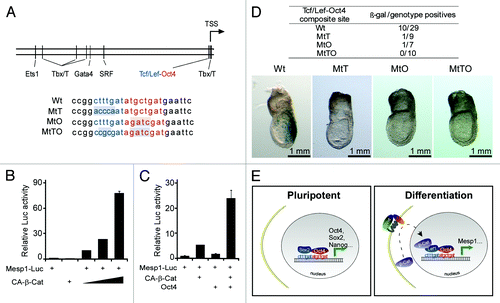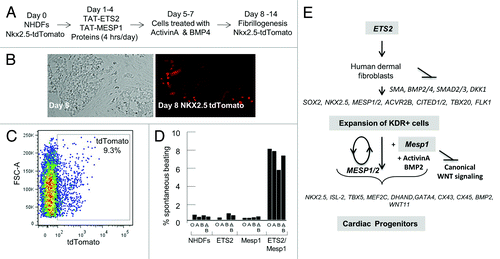Figures & data
Figure 1. A Tcf/Lef-Oct4 site mediates the cooperation of Oct4 and canonical Wnt on the Mesp1 promoter. (A) Schematic diagram of conserved transcription factor binding site predicted by rVista. The Tcf/Lef-Oct4 site and adjacent sequence are shown. Blue characters mark the Tcf/Lef site, and red mark the “octamer” Oct4 site. Shaded characters mark the point mutations used in this study. (B) Constitutively active β-Catenin stimulated the Mesp1-Luc reporter in a dose-dependent manner. (C) Oct4 synergized with CA-β-Cat in co-activating the Mesp1-Luc reporter, albeit Oct4 only marginally activated it. (D) Mutations on the Tcf/Lef-Oct4 site impaired Mesp1-LacZ expression in a transient transgenic assay. The table summarizes the number of β-galactosidase positives vs. genotype positives in each wildtype or mutant group. Images on the bottom show typical results of the LacZ staining from each group. (E) A working model of Oct4’s role in sustaining pluripotency and inducing differentiation. Through sequence-identical composite sites, a Sox2-Oct4 tandem and a Tcf/Lef-Oct4 tandem regulate pluripotency and differentiation, respectively.

Figure 2. MESP1 and ETS2 reprogram human dermal fibroblasts into cardiac progenitor cells. (A) A reprogramming protocol using purified TAT-ETS2 and TAT-MESP1 to transduce NHDFs. (B) Within 8 d after the beginning of combined ETS2 and MESP1 protein treatment, NKX2.5-tdTomato+ cells appeared in colonies of cellular aggregates. Magnification, 10 × . (C) FACS analysis revealed a conversion of about 9% of the NHDFs that were tdTomato+. (D) Percentages of spontaneously beating cells after Dox-induced conversion of NHDFs by ETS2 and MESP1 in the absence (O) and presence of Activin A (A) and BMP2 (B). (E) Model for reprogramming of human fibroblasts into cardiac progenitors induced by overexpression of ETS2 and MESP1 or treatment with purified proteins, as supported by data from our study.
